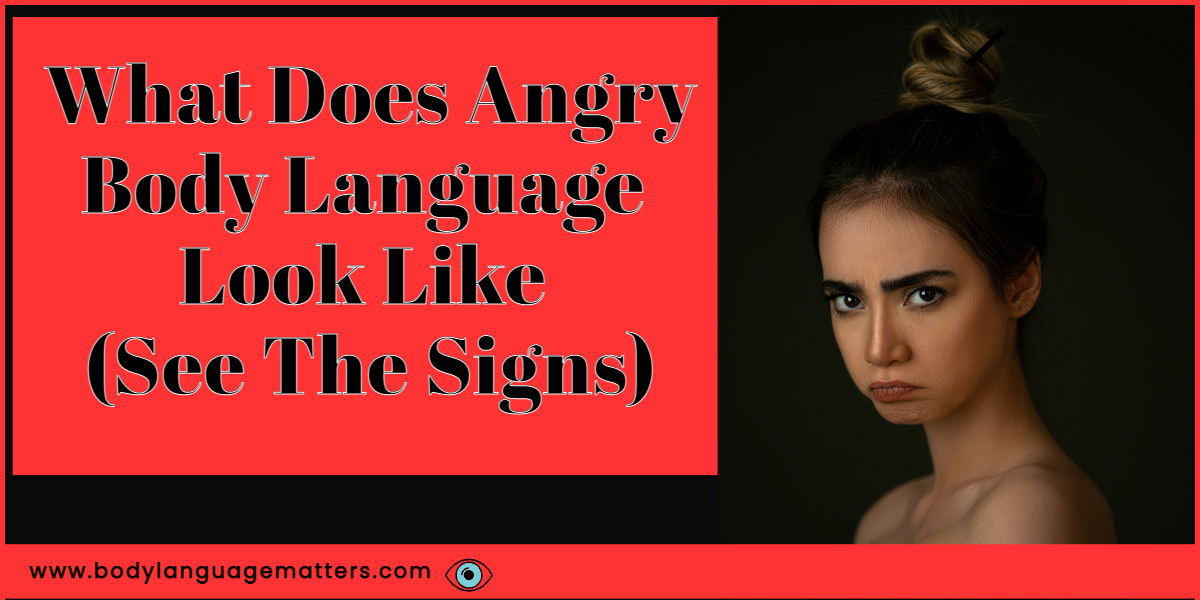Body language can be interpreted in many different ways, but there are clear signs that it communicates anger.
Angry body language can take many forms, including redness of the face, clenching of the hands into a fist, and tension at the temples. You will also notice their body becoming tenser or tensing up and a shift in breathing is another common sign of anger.
When we feel attacked or frustrated, we automatically prepare to defend ourselves and this is a natural response. This response is called the ‘fight-flight-freeze pattern.
You will notice your body tense up as your mind prepares to fight your corner and people around you will pick up on your body language shift and energy change.
We will take a look below at more ways to defuse angry body language and how to disguise your nonverbals in more detail below.
What Doe’s Your Body Language Look Like When You’re Angry

There will be times in your life when you become angry with others. Friends, family members, and even work colleagues. Knowing what you look like when you’re angry and your body language signs could save you from a sticky situation.
Most angry people use their facial expressions that might include a frown, tightened lips, clenched teeth, and flared nostrils.
If you want to know what you look like when you become angry then looking in a mirror won’t work. The best thing you can do is work through the feeling in order to get a true look at yourself.
Body language to recognize when you become angry. You may use a forced smile. You won’t want to make eye contact. Your head will go down depending on how angry you are.
Your facial expressions will not match what you’re saying. Your voice tone will become higher as your adrenaline rushes around your body.
If you notice any of the above before the red mist comes down, the best thing to do is to walk away without saying a word. You could also try grabbing something soft like a pillow or teddy bear and squeezing it until that anger passes. The most important thing is to get yourself out of the situation that is making you angry.
How To Tell When Someone Is Becoming Angry With Body Language

One of the most noticeable and common signs that someone is becoming increasingly angry is their body language. The person may become more rigid or start to fidget with their hands or hair. They might also experience a sudden rise in voice volume, which can be a sign of anger.
In order to tell if someone is becoming angry, it is important to be able to identify other signs such as whether they are raising their voice, changing the intensity of their facial expressions, or moving around a lot.
Body language should not be seen as the only sign that someone has become increasingly angry because it does not always correlate with other behaviors and can lead to false positives.
When reading body language, it is important to look for clusters of behavior. Any sudden shift in behavior is known as a behavioral change, and if you notice any changes in their body language, this could be a warning sign that they are becoming angrier.
Body Language To Look Out For When Someone Become Angry
- Facial Tension.
- Clenched fists.
- Posture change.
- Breathing shift.
- Redness in face.
- Redness in the ear.
- Staring you down.
- Body blocking.
- Arms crossed.
- Invasion of your personal space.
- Squeezing something intensely.
- Sighing (deep outward breath)
- Rubbing thighs sitting down.
- Hand blocking.
- Hands hiding face.
- Rubbing face.
- Raised shoulders.
- Flared Nostrils.
- Rigid Posture.
- Eye rolling.
- Slow blinking rate.
Teachers can use these physical cues to detect when a student is becoming angry and take appropriate action.
Parents can use these cues to gauge what their children are thinking and feeling.
Loved ones can use these cues to help their friends who may be struggling with anger.
You would need to notice more than one of the above behaviors to conclude that someone is angry. To learn more about reading body language, check out this article.
Body Language When Someone Is Angry

When someone is angry, they have gone past the point of trying to hide it or suppress their true feelings they are no longer in control of their body language as their brain has now switched from the thinking brain to the automatic brain called the amygdala.
There are various types of body language that people use when they are feeling angry. An individual may use certain gestures when they are feeling anger that may include clenching their fists, shaking hands, pulling at the earlobes, rubbing their hands over their face, or touching their chin or rubbing it intensely.
When you notice the nonverbal body language of an angry person, it’s best to avoid them. Don’t tell them to calm down as they are not thinking rationally. It’s best to advocate the situation until they have calmed down.
How To Control Body Language When Angry

Once you notice you are angry about something that means you are now back in control you are not acting on your impulses.
You have become aware of the feeling and can now take action in order to control or shift your behavior or feeling.
There are five steps to controlling body language when angry:
- Acknowledge the feeling.
- Take deep breaths.
- Find a distraction.
- Do not make any sudden movements.
- Use relaxation techniques.
Controlling your body language when angry is just about changing your state back to your baseline or normal state. This will shift your body language back to your normal state. It’s not about controlling your nonverbals; it’s about shifting your mood and the rest will take care of itself.
Body Language When Dealing With Angry Customers

Body language is an important factor in dealing with angry customers.
When someone becomes angry, the person’s voice may become louder and more forceful, or they may raise their hands in frustration.
If you are dealing with an angry customer, body language is the best way to understand how to handle them.
Using your body language can help to distress the situation and bring the customer back to a normal state.
You should use a Duchenne smile. This is where you smile with the corner of your eyes and the smile fades away. As hard as this may be, are trying to calm the angry customer down.
Use open body language, such as open-handed gestures, open arms, and feet pointed towards them.
Once you have your body language correct you can then get into persuading them with your words.
How To Show Anger With Body Language

Body language is the most common way to express anger. The key to showing anger with your body language is to just let it go. However, if you’re acting or want to fake anger, there are some things you can do to project anger with your body language.
Angry Body Language Gestures.
- Create a have a red face.
- Raise your eyebrows.
- Clenched your fists.
- Tense your jaw.
- Grind their teeth together.
- Point at them.
- Fold your arms.
- Look at them intensely.
Summary
Body language can be hard to read correctly. What makes body language difficult to read is that it varies depending on different cultures and regions, which can make it hard to determine what people are feeling.
The worst thing that you can do in a situation with someone who is upset, frustrated, or angry is try to talk them out of their feelings. This will only make them angrier.
The best thing you can do is be empathetic and try to find out what caused the anger so they feel heard.
It’s also important for you not to show any signs of anger or frustration when communicating with someone who has angry body language because this will only escalate the situation further.
The best thing to do is allow them to calm down naturally and address the situation afterward if needed.
We hope this post has been of interest to you, and if you would like to know more about body language or nonverbal communication, please check out more here.

